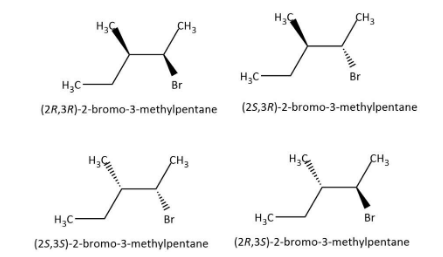
Answer
441.9k+ views
Hint:We know that in case peroxide is present, addition of ${\rm{HBr}}$ follows anti-Markovnikov rule and number of possible stereoisomers can be deduced from the number of chiral centres.
Complete step-by-step answer:Let’s start by having a look at our given alkene that is \[3 - {\rm{methylpent}} - 2 - {\rm{ene}}\]. We can draw the structure for this alkene as follows:

As we can see that it is an unsymmetrical alkene, so we have to be careful with the addition of ${\rm{HBr}}$ to this. Usually we would follow Markovnikov rule but now we are doing addition in the presence of peroxide. So, we have to follow the anti-Markovnikov rule and we will see that less substituted carbon will get priority. Let’s write the addition reaction as follows:

Now that we have our addition product, let’s find out how many chiral centres are there in this molecule by identifying carbon atoms that are bonded to four different substituents.

In the addition product, we can see that the first carbon has three hydrogen atoms, second and third carbons have four different substituents, fourth has two hydrogen atoms and fifth has three hydrogen atoms. So, we can say that we have two chiral centres in our addition product.
Now we can find out the number of possible stereoisomers as ${2^2} = 4$, to be four. We can draw the structures of the four stereoisomers as follows:

Hence, the correct option is C.
Note: We can understand the formation of the product according to the anti-Markovnikov rule as participation of peroxide in the free radical mechanism and giving rise to peroxide effect.
Complete step-by-step answer:Let’s start by having a look at our given alkene that is \[3 - {\rm{methylpent}} - 2 - {\rm{ene}}\]. We can draw the structure for this alkene as follows:

As we can see that it is an unsymmetrical alkene, so we have to be careful with the addition of ${\rm{HBr}}$ to this. Usually we would follow Markovnikov rule but now we are doing addition in the presence of peroxide. So, we have to follow the anti-Markovnikov rule and we will see that less substituted carbon will get priority. Let’s write the addition reaction as follows:

Now that we have our addition product, let’s find out how many chiral centres are there in this molecule by identifying carbon atoms that are bonded to four different substituents.

In the addition product, we can see that the first carbon has three hydrogen atoms, second and third carbons have four different substituents, fourth has two hydrogen atoms and fifth has three hydrogen atoms. So, we can say that we have two chiral centres in our addition product.
Now we can find out the number of possible stereoisomers as ${2^2} = 4$, to be four. We can draw the structures of the four stereoisomers as follows:

Hence, the correct option is C.
Note: We can understand the formation of the product according to the anti-Markovnikov rule as participation of peroxide in the free radical mechanism and giving rise to peroxide effect.
Recently Updated Pages
10 Examples of Evaporation in Daily Life with Explanations

10 Examples of Diffusion in Everyday Life

1 g of dry green algae absorb 47 times 10 3 moles of class 11 chemistry CBSE

What happens when dilute hydrochloric acid is added class 10 chemistry JEE_Main

What is the meaning of celestial class 10 social science CBSE

What causes groundwater depletion How can it be re class 10 chemistry CBSE

Trending doubts
Fill the blanks with the suitable prepositions 1 The class 9 english CBSE

Which are the Top 10 Largest Countries of the World?

How do you graph the function fx 4x class 9 maths CBSE

Differentiate between homogeneous and heterogeneous class 12 chemistry CBSE

Difference between Prokaryotic cell and Eukaryotic class 11 biology CBSE

Change the following sentences into negative and interrogative class 10 english CBSE

The Equation xxx + 2 is Satisfied when x is Equal to Class 10 Maths

Why is there a time difference of about 5 hours between class 10 social science CBSE

Give 10 examples for herbs , shrubs , climbers , creepers




